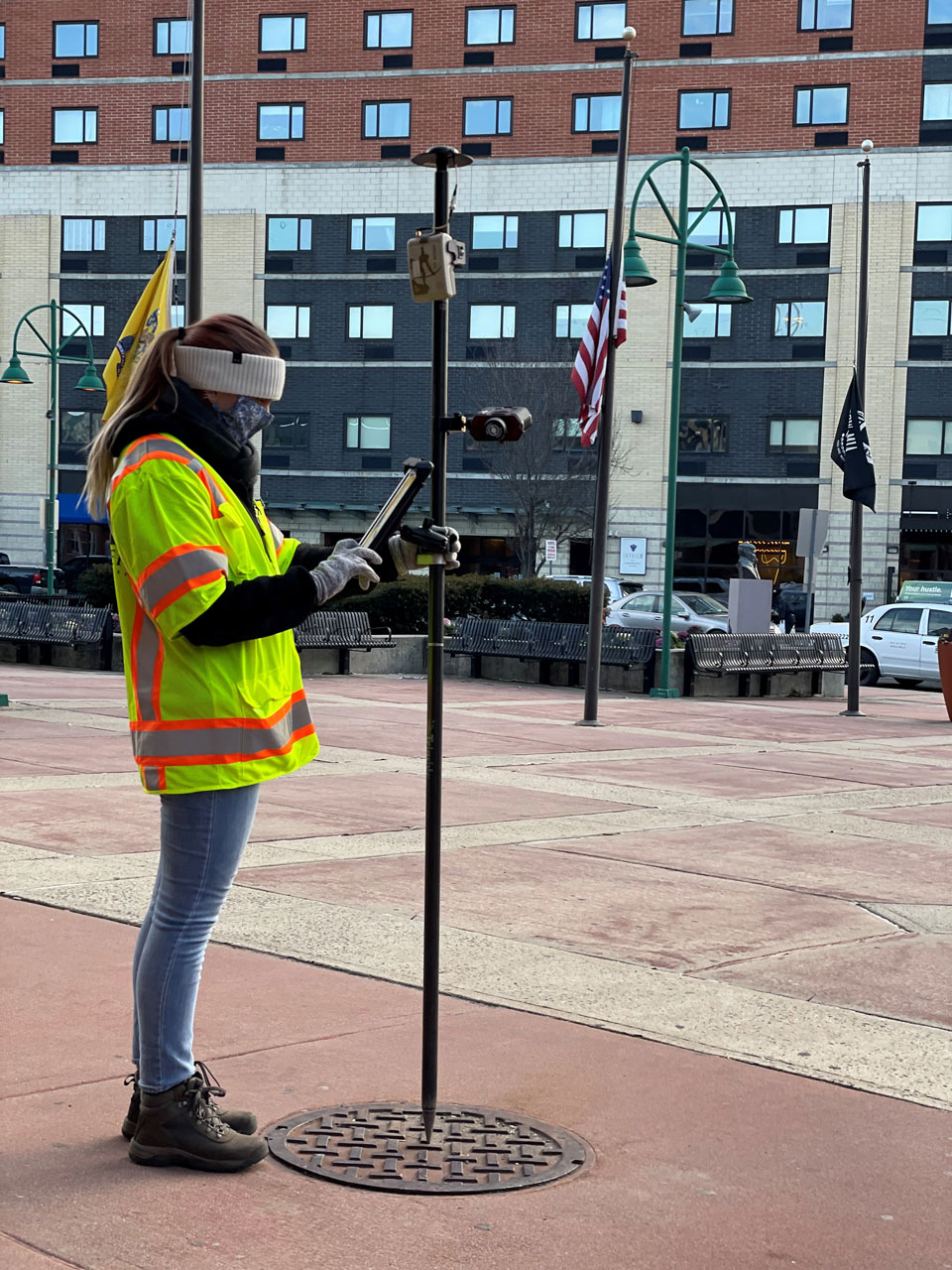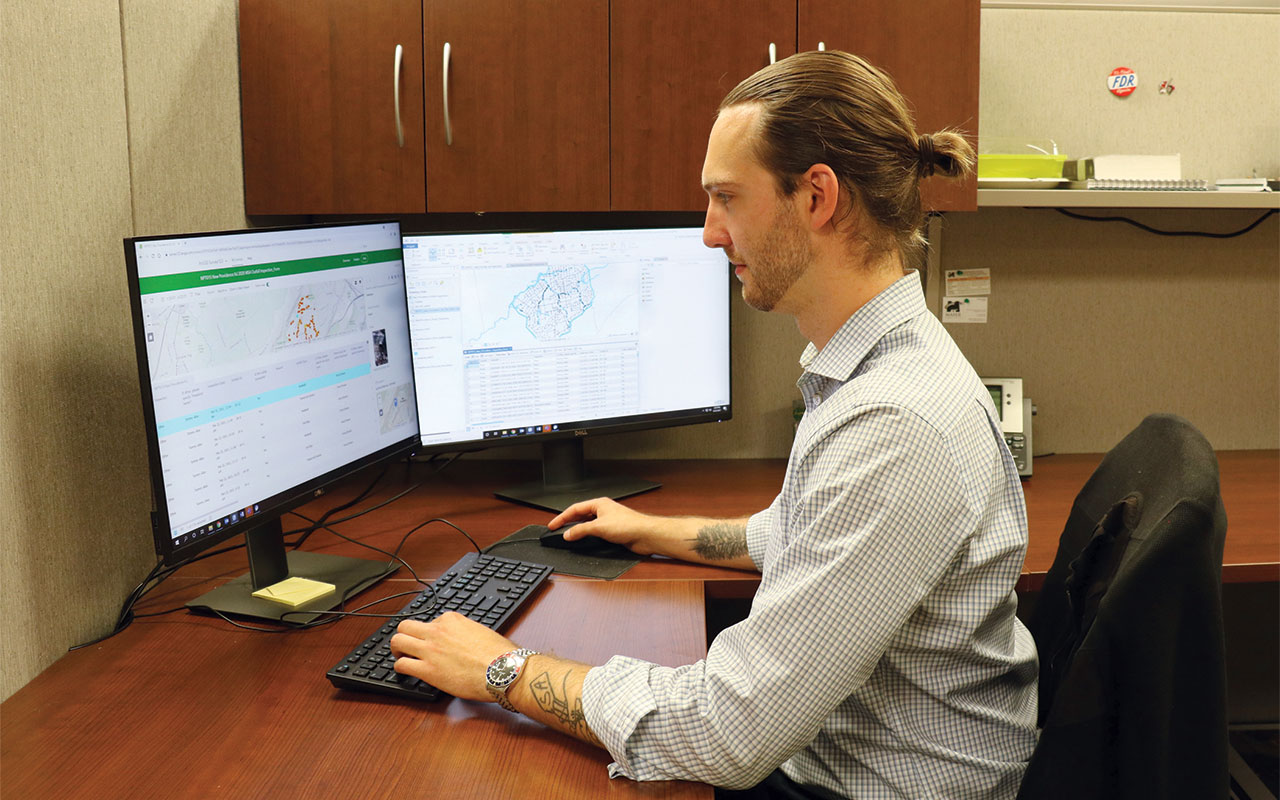From Office to Field: GIS Workers Unite
Welcome to the second segment of our GIS 123 series! Last time we learned how one Colliers Engineering & Design employee stays connected to us while working from a client’s office. This time, we are going to hear what it’s like to be employees who work simultaneously in the field and office from two completely different locations. What does a day in the field look like? Why might they need to go from one type of setting to the other? To answer these questions and more, we asked GIS Specialist Amanda Paton and GIS Technician Tommy Allen.
Why Do They Like It?
 Amanda described GIS as “the gathering of data from assets in the field to help the client better understand the location, maintenance, condition and other details about these assets. This enhances organization, increases efficiency, and displays data visually. With GIS clients can thus better manage their assets.” Once the data is collected in the field, we send files digitally in real-time to the office to be turned into client deliverables. Tommy and Amanda explained that to do this, they each spend some days in the office and some days in the field. Because GIS is web-based, they can work on the same project, even though they live in different states. The GIS department has team members all over the country sharing information instantaneously.
Amanda described GIS as “the gathering of data from assets in the field to help the client better understand the location, maintenance, condition and other details about these assets. This enhances organization, increases efficiency, and displays data visually. With GIS clients can thus better manage their assets.” Once the data is collected in the field, we send files digitally in real-time to the office to be turned into client deliverables. Tommy and Amanda explained that to do this, they each spend some days in the office and some days in the field. Because GIS is web-based, they can work on the same project, even though they live in different states. The GIS department has team members all over the country sharing information instantaneously.
Amanda said, “Working both in the field and office settings gives us a greater understanding of what we are mapping, what GIS does, and the story we are telling. By seeing a project site with my own eyes, I see the whole picture more easily than if I was only seeing data on my computer in the office.”
Tommy added, “It is good for our mental health to work in a variety of environments and overcome unique challenges. It’s impossible to get bored or get into a rut when you change things up as frequently as we do. It’s also helpful for relationship building. Discussing asset management with clients is often easier in person.”
Prep
Amanda started by saying, “The night before, I do a health and safety check. Each check is customized to meet the environment of the specific job site and address its hazards. The night before I also make sure all the equipment is charged and ready to use. The morning of, I call my manager and go over our plan. When I get there, I turn on the tracker that enables the team members who are in the office to know exactly where I am.”
This tracker has many uses, such as helping field workers keep track of what land they’ve already covered. But Amanda pointed out another great benefit, saying, “As a female, this makes me feel a lot safer when I have to knock on someone’s front door and ask if I can walk across their property, or if I’m ever alone doing a scan. My team always knows exactly where I am, so I don’t have to worry about strangers the same way I would if we didn’t have that technology.”
A Day in the Field
GIS workers collect data about a variety of different assets such as manholes (both Sanitary and Stormwater), catch basins, outfalls, fire hydrants, valves. When they collect this data, they are not only collecting the GPS location of the assets, but also highly detailed information about them. This includes type, size, condition, and material and can be customized for each asset type. They use Esri’s ArcGIS Field Maps app on an iPad with EOS Arrow Gold GPS equipment to collect the GPS points as well as details associated with it. For busy intersections/roadways they can use the TruPulse Laser rangefinder to safely collect the assets.
Amanda explained, “We usually arrive in the town we are working performing work for and figure out a good place to start based on the type of assets we are collecting. For outfalls, a good place to start is at the place where the river enters the municipal boundary and then work our way along the waterbody and across the town.”
She continued, “If we are doing manholes, catch basins, hydrants, valves, we will pick a place to park the car and figure out a planned path that we can follow up and down a few of the blocks in the area so that it will lead us back to the car. Then we will move the car to a new area and do that area.” This can maximize the amount of assets they collect because they actively avoid wasting time.
Ready for Anything
Not every day on a jobsite looks the same. Some days in the field consist of walking ten miles a day. Some are in the woods. Some are dealing with traffic on the side of a road. Each environment has its own safety concerns. For example, Amanda said, “Working on manholes usually means dealing with traffic concerns and distracted drivers.”
Tommy said, “A day in the field can be physically exhausting, so we take breaks throughout the day. Especially in extreme cold and heat. If there is a problem in the field, we call the team in the office as soon as it arises. We make adjustments as need be. We notify the team of any discrepancies between the plan and what is happening in real time.”
At the end of the day they call their manager to let them know they are leaving the site. Then they make sure to put away all the equipment properly and charging, ready for their next field day. Tommy spends almost every day in the field. But usually there are only about two people on the team out on a given day. Everyone else works in the office.
In the Office
 To gear-up for a day in the field, they need to complete in-office preparation work. Often, they complete office work after as well. There’s also office work that the GIS department does separate from pre/post-site visits. Amanda has been spending more of her days in the office than the field lately. But, she said splitting her time as close to 50/50 as possible would be her ideal scenario. Tommy agreed, noting that the variety keeps things interesting.
To gear-up for a day in the field, they need to complete in-office preparation work. Often, they complete office work after as well. There’s also office work that the GIS department does separate from pre/post-site visits. Amanda has been spending more of her days in the office than the field lately. But, she said splitting her time as close to 50/50 as possible would be her ideal scenario. Tommy agreed, noting that the variety keeps things interesting.
What does a typical day in the office look like? Amanda said, “I start my day checking my email and checking our running excel document of tasks. It’s a clear list of what is assigned to whom and when each item is due. With it, the whole team is very much on the same page at all times. Then, I just complete my tasks in the office at my desk. Field days are usually around ten hours and in a wide variety of environments. Days in the office look much more like employees from other departments might expect.”
A Connected Team
Like JR did in our last GIS blog, both Amanda and Tommy emphasized how connected they feel to their team, to each other, and to the company. Their daily phone calls and emails, and their weekly team video calls all contribute to that. Tommy emphasized, “Most importantly is the tone that our managers have set in place. They value output over formalities. Therefore, we feel completely comfortable to ask them questions and make suggestions as we see fit. We don’t walk on eggshells or worry about being overly formal with each other. We all just want to get our jobs done as well as possible. That spirit creates comradery and trust within our team.”
Whether it’s Tommy out on a job-site in NJ talking in real-time with Amanda in her Raleigh, NC office, or Amanda on a job-site in NC sending data back to Red Bank NJ, it’s clear that there’s always high communication happening within the GIS team.
Stay tuned for Part 3 of GIS123, where we will examine what it’s like to be simultaneously working and in school, spotlighting Peter Erlenbach, GIS Specialist from our Charlotte NC office.

May 26, 2021 at 11:29 pm, Bukenya Janan said:
Am greatly appreciate for this article it will be of good help thanks to the team